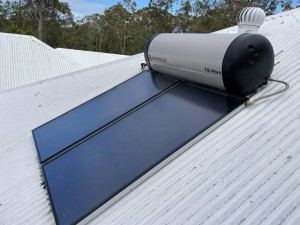Many Australians are turning to solar hot water systems to reduce their bills and make their homes more eco-friendly. However, not everyone knows how they work. In this post, we find out. We explore what a solar water heater is, the technology that it uses, and whether it is worth the money. Read on to learn more.
What Is A Solar Hot Water Heater?
A solar hot water heater is a device that transforms solar energy (abundant in Australia) into heat that you can use to warm your home. They are popular in warmer climates such as Brisbane, Perth and Darwin because of their ample exposure to the sun’s energy, though people benefit from them all over the country.
Solar hot water systems feature energy-collecting panels and a storage tank. However, systems can differ slightly from each other, as we discuss below.
How Solar Hot Water Systems Work
Here’s a quick rundown of how solar hot water systems heat water:
Step 1: Transfer Cold Water To The Solar Collector
Before the sun acts on the water in collectors, it starts off as cold in a storage tank. Usually, water is stored on the ground. If this is the case, an electric pump pumps it up to the collector on the roof. If your home stores water on the roof, then it filters down naturally into the collectors since cold water is heavier than hot and passively circulates.
Step 2: The Collector Heats The Water
In the next step, the solar collector heats the water. Manufacturers make collectors from materials that are extremely effective at conducting solar radiation, increasing efficiency. Water travels through pipes from storage tanks to the collector where it receives the sun’s energy.
Step 3: Heated Water Returns To The Storage Tank
Once heated in the collectors, a stream of warm water returns to the storage tank. If you have a thermosiphon system, this happens automatically, since hot water is lighter than cold. If you have a ground-based tank, a pump transfers new warm water to ground level and keeps the system circulating.
Step 4: Hot Water Becomes Ready To Use
Once the system goes through several cycles, the average temperature of the water in the storage tank increases considerably. Eventually, it becomes warm enough for household use.
Many solar hot water systems tell you when they reach this point, usually after several hours of heating. In most instances, systems provide sufficient hot water for all a regular household’s needs, including showers, baths, and washing up for multiple people.
If sunlight is low or usage is high for whatever reason, you can install ancillary electric heaters that kick into action if passive solar heating is insufficient.
What Is The Difference Between A Solar Hot Water System And A Heat Pump?
Solar hot water systems and heat pumps are both eco-friendly ways for Australians to heat their homes. However, heat pumps work differently.
Heat pumps do not use collectors to collect solar energy. Rather, they use heat from the air to warm water.
Heat pumps work by pulling in the air across an evaporator, similar to air conditioning units. The evaporator converts refrigerant liquid into a gas and pressurises it. The gas heats up inside condenser coils in contact with water, heating it up.
Unlike passive solar hot water heaters, heat pumps use electricity. However, consumption is typically around three-quarters less than conventional electric heaters.
Do Solar Hot Water Systems Continue Providing Hot Water At Night?
Once the sun goes down, solar hot water heaters can no longer derive energy from it to heat water. Even so, insulated hot water tanks will usually keep water warm for many hours, letting you use hot water at night time and first thing in the morning.
If you notice water temperatures falling at night, consider improving the insulation around your tank or installing an electric booster. Adding a small amount of conventional heating to a solar hot water system will still reduce your overall energy consumption.
Do Solar Hot Water Systems Continue Working In Cold Weather?
While Australian winters are mild compared to those in Europe and North America, temperatures can still plummet, particularly at night. Because of this, owners wonder whether their system will continue to provide service, even during a cold snap.
The answer is usually, yes. That’s because solar hot water systems rely on radiative heating, not conductive heating. Even if the air temperature is cold, solar energy will continue to provide heating.
In the winter, however, the sun is lower in the sky. Because of this, the total energy it imparts per square metre is lower. Therefore, it may take water longer to heat up.
Cloud cover will also reduce solar heater efficiency, but not by much. Radiative energy from the sun reaching the ground is still relatively high (which is why overcast days do not look like night).
Again, in rare cases where solar hot water systems do not provide sufficient energy, you can install gas or electric boosters. These top-up your heating, ensuring that your hot water tank maintains a minimum acceptable temperature.
Does It Make Financial Sense To Invest In A Solar Hot Water Heater?
In Australia, most people stand to benefit from a solar hot water heater. Plentiful access to solar radiation, particularly in the summer, means that these systems can deliver sufficient hot water to most homes 24 hours a day, year-round.
Solar hot water systems reduce energy bills considerably. Estimates suggest that around 25 percent of total home energy use goes into heating water. Therefore, a solar hot water system could reduce costs by a quarter. Adding conventional photovoltaic solar panels could reduce bills even more.
For people interested in sustainability, these systems offer additional benefits. Solar hot water heaters reduce your impact on the environment.
The government also offers various incentives and rebates. On average, you may be able to save around $1,000 on your solar hot water system installation.


